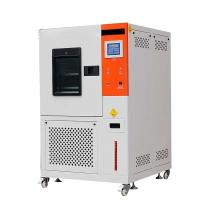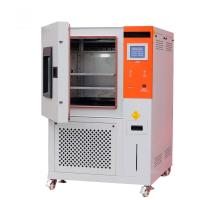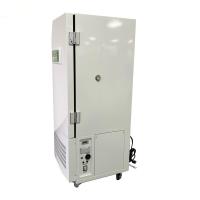In the modern era of materials science and product development,
understanding the impact of ultraviolet (UV) radiation is of utmost
significance. The Customized UV Climatic Chamber is a revolutionary
tool that allows for precise simulation and analysis of UV
exposure, catering to a wide range of industries.
This state-of-the-art chamber is designed to replicate various UV
radiation conditions that products may encounter in real-world
scenarios. It serves industries such as automotive, aerospace,
plastics, coatings, and textiles. The primary objective is to
evaluate how materials and products respond to UV light over time,
including effects like color fading, material degradation, loss of
mechanical properties, and chemical changes. By subjecting samples
to controlled UV environments, manufacturers and researchers can
make informed decisions about material selection, product design,
and durability enhancements.
- Durable and Light-Tight Construction
- The chamber is constructed with a high-strength alloy framework
that provides stability and durability. The interior is lined with
a highly reflective and UV-absorbing material to ensure maximum
utilization of the UV light source and prevent any unwanted
reflections or stray radiation. The door is engineered with a
multi-seal mechanism, incorporating a UV-resistant gasket and a
secure locking system, maintaining a light-tight and controlled
testing environment. The chamber also features a small viewing
window made of UV-blocking glass, allowing for visual inspection
without compromising the integrity of the test.
- Precision UV Emission and Control Systems
- UV Source: Equipped with a high-intensity UV lamp array that can
emit UV radiation across a wide spectrum, typically ranging from
UVA (315-400nm) to UVC (100-280nm). The lamps are carefully
calibrated and monitored to ensure consistent and accurate UV
output. The power and intensity of the UV emission can be precisely
controlled, allowing for the simulation of different environmental
UV levels, from mild sunlight exposure to intense industrial UV
curing conditions.
- Spectral Control: The chamber incorporates a spectral filter system
that enables the selection and adjustment of specific UV
wavelengths. This is crucial for testing the effects of different
UV bands on materials. For example, UVA is often associated with
long-term material aging, while UVC is more germicidal and can
cause rapid chemical changes. The ability to isolate and vary these
wavelengths provides detailed insights into material behavior.
- Intensity and Exposure Time Control: The user-friendly control
panel allows for precise programming of UV intensity levels and
exposure times. The intensity can be adjusted from a few milliwatts
per square centimeter to several watts per square centimeter, and
the exposure time can range from a few minutes to thousands of
hours, replicating short-term product use scenarios as well as
long-term outdoor exposure.
- Advanced Instrumentation and Data Acquisition
- The chamber is outfitted with a comprehensive suite of sensors and
instrumentation. In addition to UV intensity sensors, it includes
sensors for measuring temperature, humidity (as UV exposure can
sometimes interact with moisture to affect materials differently),
and even some chambers can be equipped with sensors for detecting
chemical changes or gas emissions from the tested samples. These
sensors are connected to a state-of-the-art data acquisition system
that records and stores all relevant data. The data acquisition
system offers a high sampling rate, typically ranging from 100 to
1000 samples per second, ensuring that even the most rapid changes
in environmental conditions or sample properties are accurately
captured. The collected data can be accessed and analyzed in
real-time or retrieved later for in-depth studies. The system is
also compatible with industry-specific data analysis software,
enabling the generation of detailed reports and graphical
representations of the test results.
- Safety and Compliance Features
- The Customized UV Climatic Chamber is designed with multiple safety
features. It has an automatic shutdown system in case of any
critical malfunction, such as overheating of the UV lamps or
excessive radiation levels. The chamber is also equipped with a
ventilation system to remove any potentially harmful gases or
vapors that may be generated during the UV-induced chemical
reactions. The control panel is designed with safety interlocks and
clear warning indicators to prevent accidental operation and ensure
the well-being of personnel. Additionally, the chamber complies
with relevant industry standards and regulations regarding UV
exposure testing, ensuring that the testing procedures are reliable
and recognized within the industry.
- Chamber Size and Capacity: The chamber is available in various sizes, from small benchtop
models with a volume of a few liters, suitable for testing small
samples like fabric swatches or plastic components, to larger
floor-standing units with volumes up to several cubic meters,
capable of accommodating larger products or multiple samples
simultaneously. The interior dimensions are optimized for uniform
UV distribution and proper air circulation, ensuring that all parts
of the tested samples receive consistent exposure.
- UV Wavelength Range and Resolution: The UV lamp array can cover a wavelength range from 100nm to
400nm with a resolution of typically ±5nm. This allows for detailed
studies of the effects of specific UV wavelengths on materials. For
example, a resolution of ±5nm enables the differentiation between
the impacts of 320nm and 325nm UV light on a particular polymer,
which could be crucial in understanding its degradation mechanism.
- UV Intensity Range and Accuracy: The intensity of the UV radiation can be adjusted from 0.1 mW/cm²
to 10 W/cm² with an accuracy of ±10%. This wide range and accuracy
are essential for simulating different real-world UV scenarios. For
instance, a low-intensity setting of 0.1 mW/cm² might be used to
mimic the UV exposure in a shaded outdoor area, while a
high-intensity of 10 W/cm² could replicate the conditions in a UV
curing chamber for industrial coatings.
- Temperature and Humidity Range: The chamber can maintain a temperature range from -20°C to +80°C
with an accuracy of ±1°C and a humidity range from 10% to 95% RH
with an accuracy of ±3% RH. These parameters are important as they
can influence the rate and nature of UV-induced changes in
materials. For example, higher humidity levels may accelerate the
degradation of some materials when combined with UV exposure.
- Data Acquisition Rate: The data acquisition system samples sensor data at a rate of 500
samples per second, ensuring that even the slightest and most rapid
changes in UV intensity, temperature, humidity, or other parameters
during the test are accurately recorded and can be analyzed in
detail.
- Compliance with Industry Standards: Complies with standards such as ASTM G154 for UV exposure of
plastics and ISO 4892 for plastics - Methods of exposure to
laboratory light sources, ensuring that the testing is conducted in
a manner consistent with industry best practices and facilitating
the comparison of test results across different laboratories and
manufacturers.
- Accurate Simulation of UV Exposure Environments
- The primary function of this chamber is to provide a highly
accurate and realistic simulation of the UV radiation conditions
that products will face. By precisely controlling UV wavelength,
intensity, and exposure time, along with temperature and humidity,
it allows for the evaluation of how materials and products will
perform and degrade over time. For example, it can determine if a
car's exterior paint will fade and lose its gloss after prolonged
exposure to sunlight, or if a textile used in outdoor furniture
will become brittle and lose its colorfastness. This information is
invaluable for manufacturers to optimize their product designs,
select appropriate UV stabilizers or protective coatings, and
improve the overall durability and appearance of their products.
- The ability to conduct repeatable tests with different UV profiles,
as mandated by industry standards, is also a crucial function. This
helps in comparing the performance of various product versions or
materials and identifying the most suitable option. For instance, a
plastics manufacturer can test multiple formulations of a polymer
under the same set of UV, temperature, and humidity cycling
conditions and analyze the results to select the most UV-resistant
composition.
- Enhanced Product Quality and Innovation
- Through comprehensive testing in the Customized UV Climatic
Chamber, product developers can identify and address potential
issues in their designs. If a material shows signs of degradation
or failure during the test, appropriate measures can be taken, such
as adding UV absorbers, antioxidants, or changing the material's
molecular structure. This leads to the development of more reliable
and durable products, reducing the risk of premature failure and
enhancing customer satisfaction. In the research and development
field, it allows for the exploration of new materials and
technologies, providing valuable data on their behavior under UV
radiation. For example, researchers can study the performance of
new nanocomposites or bio-based materials in UV-rich environments,
opening up new possibilities for sustainable and high-performance
product development.
- The chamber also serves as a powerful tool for quality control. By
subjecting products to standardized UV tests, manufacturers can
ensure that their products meet the required quality and
performance standards. This helps in building a reputation for
quality and reliability in the market, which is essential for
long-term success.
- Compliance with Industry Standards and Regulations
- The compliance of the test chamber with relevant industry standards
is a key aspect of its functionality. Many industries have specific
regulations and standards regarding UV exposure and product
durability. By using this chamber to conduct tests in accordance
with standards like ASTM G154 or ISO 4892, manufacturers can prove
that their products are safe and reliable. Regulatory bodies and
industry customers rely on accurate test results obtained from such
chambers to enforce safety and quality regulations, ensuring the
proper functioning and longevity of products in the market.
- Stringent Manufacturing Process
- The Customized UV Climatic Chamber is manufactured under strict
quality control procedures. Each component, from the UV lamps to
the sensors and control panel, is carefully sourced and inspected
for quality and performance. The assembly process is carried out by
highly trained technicians in a clean and controlled environment.
The chamber undergoes a series of calibration and validation tests
during the manufacturing process to ensure that it meets the
required accuracy and performance standards.
- The calibration of the UV lamps, temperature, humidity, and other
sensors is a critical part of the manufacturing process. It is
performed using traceable reference standards that are calibrated
to the highest levels of accuracy, guaranteeing the reproducibility
of the test results. Rigorous quality audits and inspections are
conducted at various stages of production to maintain the highest
level of product quality and compliance with industry standards.
- Quality Certification and Validation
Our chamber has obtained relevant quality certifications and has
been validated by independent testing laboratories. It has been
proven to provide accurate and reliable test results, conforming to
the relevant industry standards. We also continuously update and
improve our product based on the latest technological advancements
and customer feedback from various industries to ensure its
long-term performance and compliance.
- Automotive Industry
- A leading automotive manufacturer used the Customized UV Climatic
Chamber to test the durability of their new car paint formulations.
The tests revealed that a particular pigment combination was more
prone to fading under intense UV exposure. By adjusting the pigment
ratios and adding UV stabilizers, they were able to improve the
paint's color retention and overall durability, enhancing the
appearance and resale value of their vehicles.
- An automotive parts supplier tested the UV resistance of their
plastic exterior trim components. The testing identified a weakness
in the material's resistance to cracking and embrittlement. By
switching to a different polymer blend and using a UV-absorbing
additive, they were able to increase the lifespan of the trim
parts, reducing warranty claims and improving customer
satisfaction.
- Aerospace Industry
- An aerospace company used the chamber to test the UV stability of
their aircraft coatings and composites. The tests showed that
certain coatings were degrading faster than expected in
high-altitude UV conditions. By developing a new coating
formulation with enhanced UV protection, they were able to improve
the long-term integrity of the aircraft's exterior, reducing
maintenance costs and ensuring flight safety.
- A research institution in the aerospace field used the Customized
UV Climatic Chamber to study the effects of UV radiation on the
performance of satellite materials. The data obtained led to the
development of new materials and shielding techniques that could
better withstand the harsh UV environment in space, increasing the
reliability and lifespan of satellites.
- Plastics and Coatings Industry
- A plastics manufacturer tested their new line of high-performance
polymers in the chamber. The testing helped them optimize the UV
stabilizer content and polymer structure to achieve maximum
durability. The resulting polymers were used in a wide range of
applications, from outdoor construction materials to consumer
electronics, providing superior UV resistance and performance.
- A coatings company used the chamber to evaluate the curing and
durability of their new UV-curable coatings. The tests enabled them
to fine-tune the coating formulation and curing process, resulting
in coatings that cured faster, had better adhesion, and exhibited
excellent UV resistance, increasing their competitiveness in the
market.
- Textile Industry
- A textile manufacturer tested their outdoor fabrics in the chamber.
The testing identified a problem with the fabric's colorfastness
and strength retention after UV exposure. By using UV-resistant
dyes and improving the fabric's finishing process, they were able
to produce fabrics that maintained their color and strength for
longer periods, making them ideal for outdoor apparel and
furnishings.
- A research institute focused on textile technology used the
Customized UV Climatic Chamber to study the effects of UV radiation
on the performance of smart textiles. The results of their studies
enabled the development of new textile materials and coatings that
could protect the embedded electronics from UV damage while
maintaining the functionality of the smart textiles.


- Pre-Sales Technical Consultation
Our team of experts provides in-depth technical consultations to
help customers understand the capabilities and suitability of the
Customized UV Climatic Chamber for their specific testing needs. We
offer demonstrations and training, tailored to the customer's
industry, to familiarize them with the operation and functionality
of the equipment before purchase. We also assist in selecting the
appropriate test methods and accessories based on the products to
be tested. - After-Sales Service and Maintenance
We offer comprehensive after-sales service, including on-site
installation and commissioning. Our technicians are available for
regular maintenance, calibration, and emergency repairs. We provide
spare parts and upgrades to keep the test chamber operating at peak
performance. We also offer service contracts that include
preventive maintenance and priority technical support, ensuring the
long-term reliability and availability of the equipment for UV
testing. - Training and Technical Support
We conduct training programs for new users to ensure they can
effectively operate the Customized UV Climatic Chamber and
interpret the test results. Our technical support team is available
24/7 to answer questions, provide troubleshooting assistance, and
offer guidance on test method optimization and compliance with
industry standards. We also provide software updates and support
for the data acquisition and analysis systems, enabling customers
to take full advantage of the latest features and technologies in
UV testing.
The Customized UV Climatic Chamber is an essential asset for any
organization involved in product development, manufacturing, or
quality control in industries where UV radiation is a concern. If
you are looking to enhance your testing capabilities, ensure
compliance with industry standards, or drive innovation in your
products, this is the ideal solution. Contact us today to learn
more and get a customized quotation. Let us help you unlock the
full potential of your product quality control and UV exposure
testing










